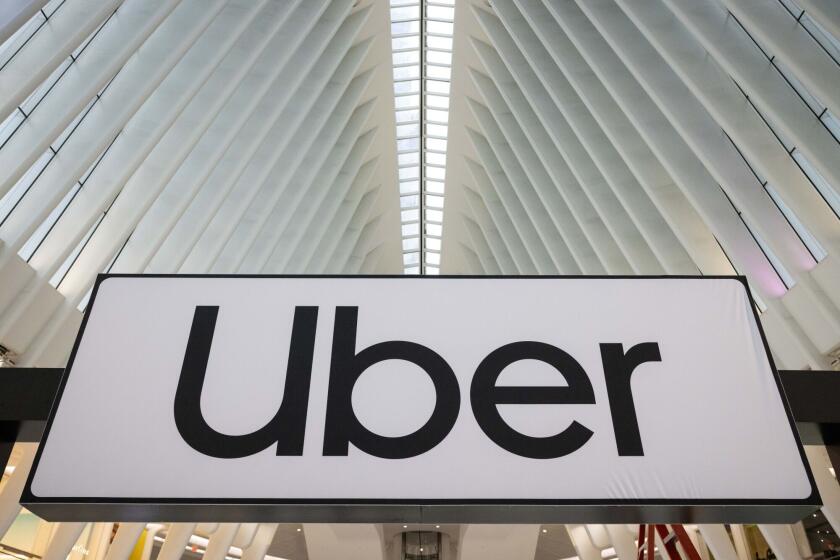COLUMN ONE : Warsaw’s Light at the End of the Tunnel : A subway in the Polish capital was first proposed 70 years ago. Now it’s finally opening. It still doesn’t reach downtown. But it’s a start.
- Share via
WARSAW — Take comfort, Los Angeles. Things could be worse.
After 70 years of planning, the Great Depression, a world war, Nazi occupation, Soviet domination, martial law, the rise and fall of communism and countless construction delays, the Polish capital is about to get its first subway.
Well, about half of one, anyway. The rest has yet to be built.
“You need 10 or 12 years without wars or economic crises to build a subway,” Warsaw Metroprojekt General Director Bohdan Zun said. “I think the last time such a situation occurred in Poland was in the 16th Century.”
The ceremonial ribbon will be cut Friday by Jan Podoski, a retired transportation engineer who at 91 holds the distinction of having been around Warsaw longer than plans for the hapless Metro. Cardinal Jozef Glemp, who is considerably younger, will follow with holy water.
The only time Poles stumbled this close to getting a subway was in 1957, when digging on the city’s East Bank was called off after six years because money ran out.
Communist authorities were so humiliated by the fiasco that it was illegal to even talk about the project for more than a decade. The uncompleted tunnel became the East Bloc’s most top-secret wine cellar.
Assuming that the guest of honor stays healthy enough--Podoski was hospitalized last week with shingles--and that authorities remain resolute enough (the opening has been on and off again for months), this obsessively self-conscious city will finally purge itself of one of its most glaring shortcomings sometime after noon Friday.
“It is a relief,” said Daniela Kondasz, a lifelong Warsaw resident who plans to treat her 7-year-old grandson to an opening-day ride. “All civilized countries in the world have a subway, but poor Poland does not. Finally, that will change.”
Generally speaking, of course.
Not unlike the unveiling of the Los Angeles Metro Rail system, the Warsaw Metro grand opening comes with a host of disclaimers and on the heels of a string of embarrassing gaffes.
The underground railway was declared ready last September, but it has taken nearly seven months to work out kinks and get everyone involved--from emergency rescue crews to garbage haulers--to grant approvals.
When an electrical short circuit filled a tunnel with black smoke last month, firefighters discovered that sufficient ventilation had not been installed and that they lacked essential communications equipment for subterranean firefighting.
Police substations at the 11 Metro stops had to be retrofitted at the last minute with new sliding jail doors because female police officers did not have the strength to maneuver the original ones. The locks were changed too when experts determined that they were designed to foil Communist-era petty thieves, not the sophisticated terrorists and mobsters of the Free World.
Authorities also realized that protective roofs were not built over entrance stairways even though inclement weather is so common here that children suffer Vitamin D deficiency because of a lack of sunshine. It was too late to erect roofs before Friday. Besides, many of the stairways are impassable because there was no money to complete them. Officials are looking to Glemp to ensure clear skies.
“The subway has become a perfect metaphor for how everything works in this country,” said Torben von Staden, managing director of Retail Properties International, commercial consultants in Warsaw. “There are a lot of problems, but it works somehow.”
*
Less than half of the 14.5-mile underground railway will actually be open for traffic. It has been 12 years since out-of-work coal and copper miners were first dragged to Warsaw to tunnel Europe’s newest underground, but no one knows when they will finish.
Work is four years behind schedule and is lagging further. Costs are double what was budgeted--the first stretch cost $600 million--and are growing. This year, the city of 1.7 million has allocated half of its capital budget to the subway, but officials predict that it could be five or 10 years before the entire system is running.
“One has to have hope,” said Tadeusz Romanowski, who retired two years ago as the project’s top designer.
His first Metro job, right out of college, was 43 years ago, drawing plans for the subway-turned-wine cellar.
“A small group of us devoted our entire professional careers to this investment,” he said. “Without hope, we wouldn’t have made it this far.”
*
Unfortunately, the completed Metro stretch goes from virtually nowhere to nowhere, making it more of an oddity than an essential transit link.
It starts in a weedy field within sight of an ugly suburb of concrete high-rises and houses packed together like sardines. It ends 6.8 miles later at a freeway overpass two stations short of downtown. There wasn’t enough money to go the extra mile.
“The line is so short that people commuting to work are going to need to change to buses,” said Tomasz Miecik, whose giveaway newspaper in the sprawling suburb of Ursynow has become the unofficial community bulletin board on Metro problems. “Many people think it will be more convenient to just take the bus the whole way.”
Miecik said the middle-class suburb is excited to get the subway, but not excited enough to give up its buses.
Strapped for cash, city officials said in January that they would slash bus routes to Ursynow when the subway opened. They soon gave in to protests, and now say a decision will come after three months of Metro operation.
Warsaw Mayor Marcin Swiecicki says that, if the city had it to do over again, construction would have begun downtown on busy Marszalkowska Street and crept its way toward the suburbs. But city officials are stuck with decisions made by their Communist predecessors, who hurriedly revived Metroprojekt in 1982 not long after making the unpopular decision to crush the Solidarity trade union and impose nationwide martial law.
“We were left with few choices,” Swiecicki said. “All we can do is keep working toward the downtown area.”
Zun, the general director, said tunneling was begun in a faraway field closer to a forest than to people because miners summoned to do the digging had no idea how to build a subway. If miners were going to learn on the job, it was deemed better that they practice beneath a field than under a major thoroughfare, he said.
“When the ground caved in on them, a tree fell in the hole,” Zun said. “If they had been under Marszalkowska, it would have been a streetcar.”
Although they acknowledge that there have been accidents, officials were unable to say whether anyone has been killed or even seriously injured during the Metro construction.
*
Communism has left its mark on the new subway in other ways.
Gen. Wojciech Jaruzelski saw the gleaming Metro as a much needed diversion from Poland’s dismal economic and political problems of the early 1980s. He turned to then-Soviet leader Leonid I. Brezhnev, who was so keen on the idea that he pledged 90 Soviet-built subway cars as a gift to the Polish effort.
But as has been its misfortune throughout the century, Metroprojekt dragged on for so long that it outlived Brezhnev and the Soviet Union itself. Poland managed to get only 10 of the cars before the Soviet collapse, and the new Russian government was considerably less charitable.
The Russians demanded cash for the remaining 80 cars. The Poles paid, but only because Western-built subway cars were three to five times more expensive. The trade-off is obvious to even the most unsophisticated traveler.
*
“The Russian cars are in a class by themselves,” Romanowski said. “They are outdated, use a lot of energy, demand a lot of maintenance, are noisy and have benches that are not very soft. But they are cheap. And we had no money.”
Communism is also blamed for the conspicuous lack of new retail development near the subway. The first 11 stations were built large enough for only a newsstand and one small shop. Aboveground, ongoing disputes over property ownership--a problem across formerly Communist Eastern Europe--and bungled city-run marketing campaigns have scared away many investors.
A recent attempt by authorities in Ursynow to sell prime land near a Metro station there was a bust: Only two bids were submitted. Still, housing values in Ursynow have jumped with the anticipated Metro opening, and retailers consider its 110,000 residents a prime Warsaw market.
But cautious investors are waiting for the downtown stations before committing large sums of money. City officials, however, are also learning the development game. Swiecicki said the city is looking for a private developer to build the main downtown station in exchange for “extremely attractive” retail or office space.
“The city must find ways to save money,” he said.
Building a subway in Warsaw was first suggested in 1925 by the director of the city’s streetcar network. Design work began, and in 1927 a city commission was set up to lay out routes.
The plan was put on hold in the early 1930s because of the Depression but was revived in 1938. Construction bids from across Europe were received, but the project was scrapped a year later when Nazi Germany invaded Poland.
In the 1950s, with the encouragement of the Soviets, construction began on a subway about five times deeper than originally planned. The Soviets wanted the underground railway as a cover for military operations, but the digging was eventually abandoned because of high costs.
*
Warsaw officials were ready when Jaruzelski decided to resurrect the project in 1982. It took just four months to pull together drawings to begin construction. About 12% of costs were devoted to equipping the subway for civil defense purposes.
In a strange quirk of history, many Poles feel indebted to Jaruzelski for finally ending the Metro jinx that spanned three generations.
The Warsaw Metro may not be perfect, they say, but Poland no longer can be grouped with the likes of Albania as a second-class European nation without a subway in its capital.
Polish prosecutors are considering charging the military dictator for his role in the fatal suppression of a 1970 workers revolt in Gdansk. But this week, the man who ruled Poland during some of the darkest days of communism is being treated as a dignitary.
Warsaw officials said Wednesday that Jaruzelski has been invited to the opening ceremony.
More to Read
Sign up for Essential California
The most important California stories and recommendations in your inbox every morning.
You may occasionally receive promotional content from the Los Angeles Times.













